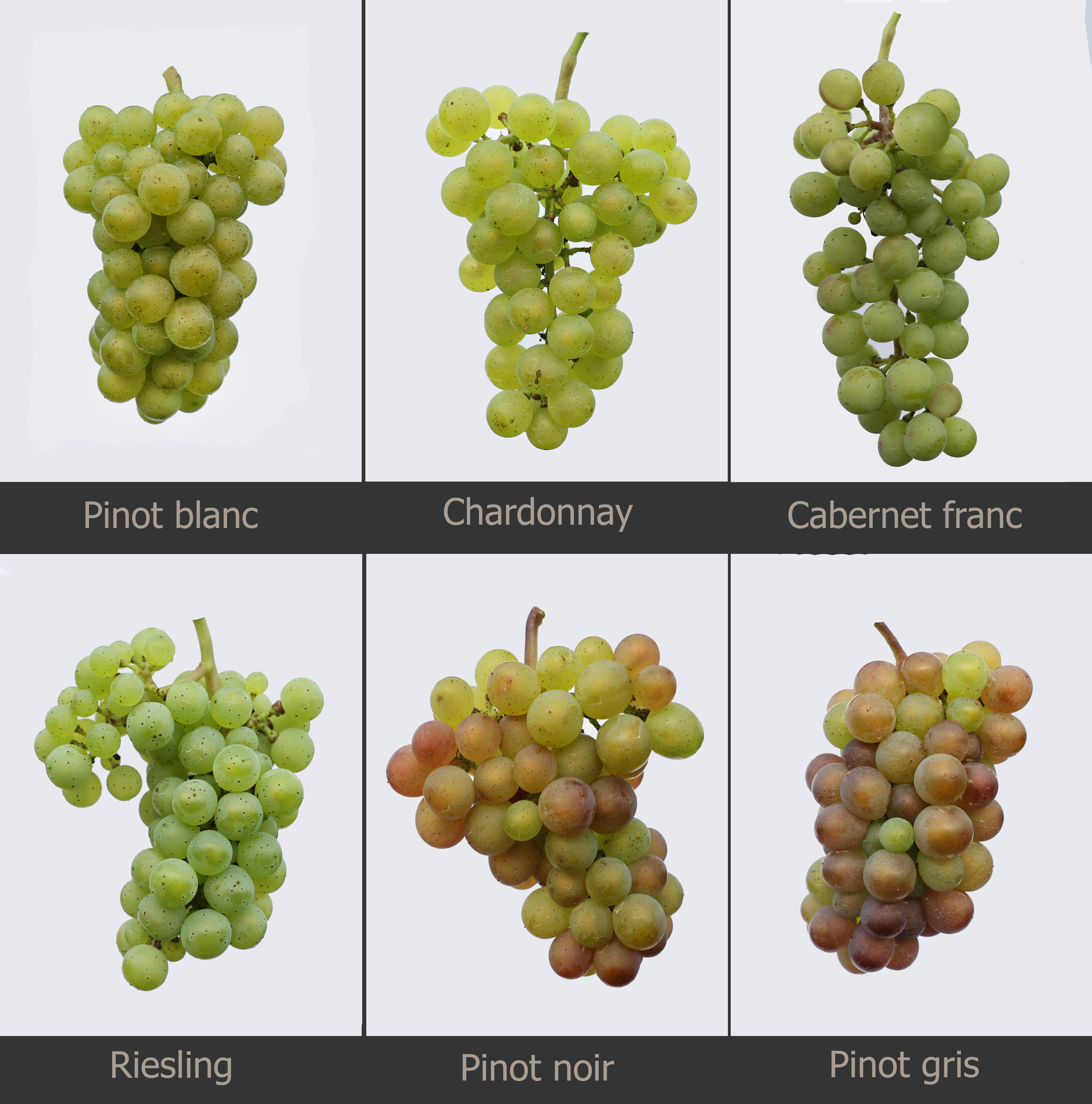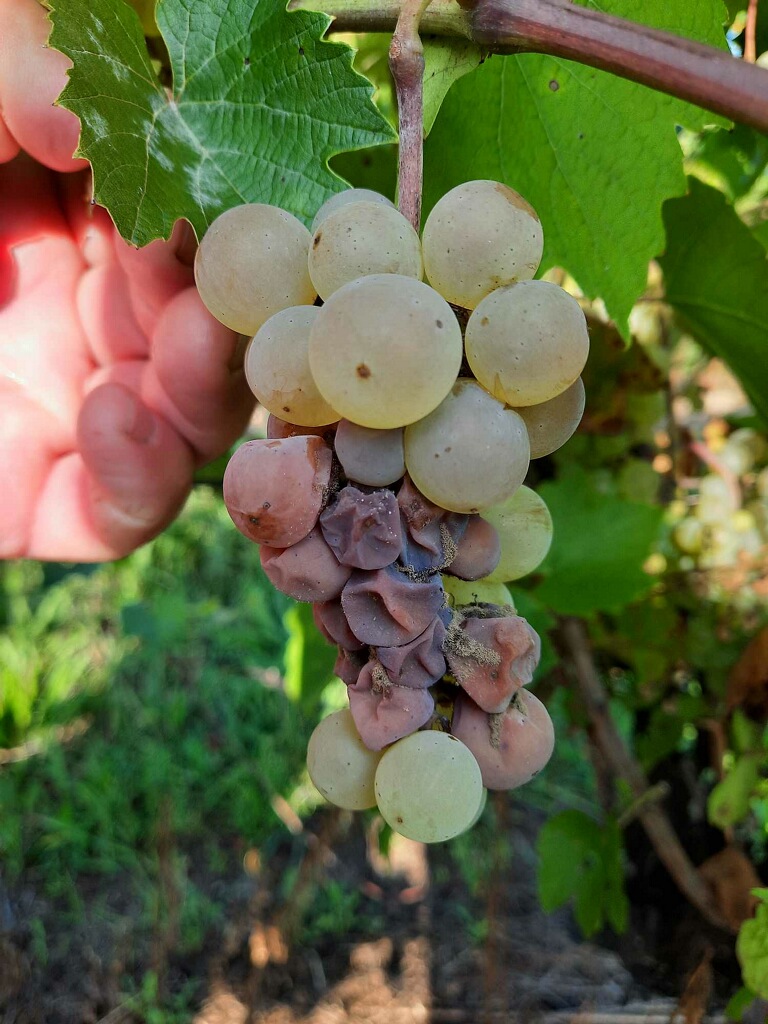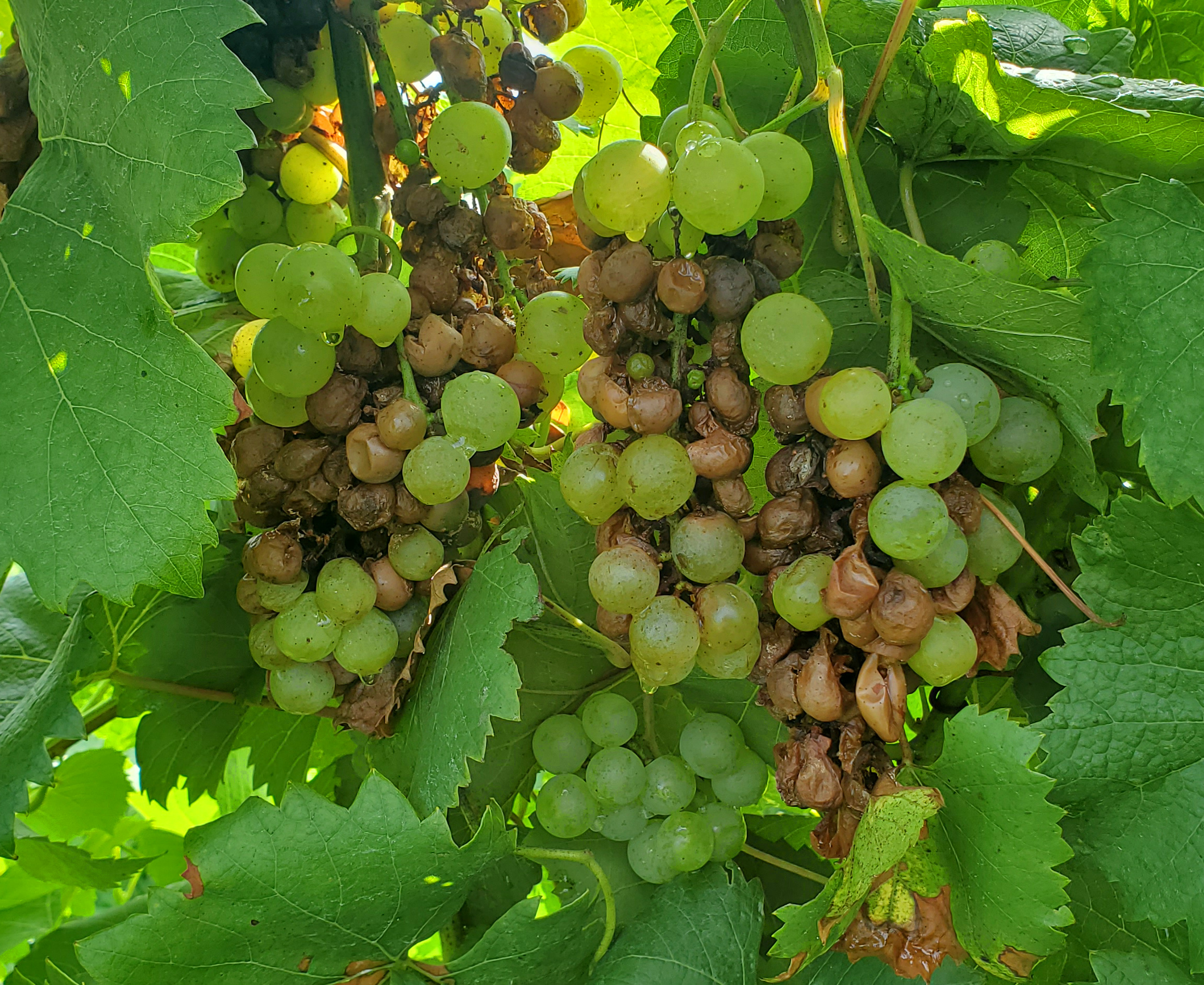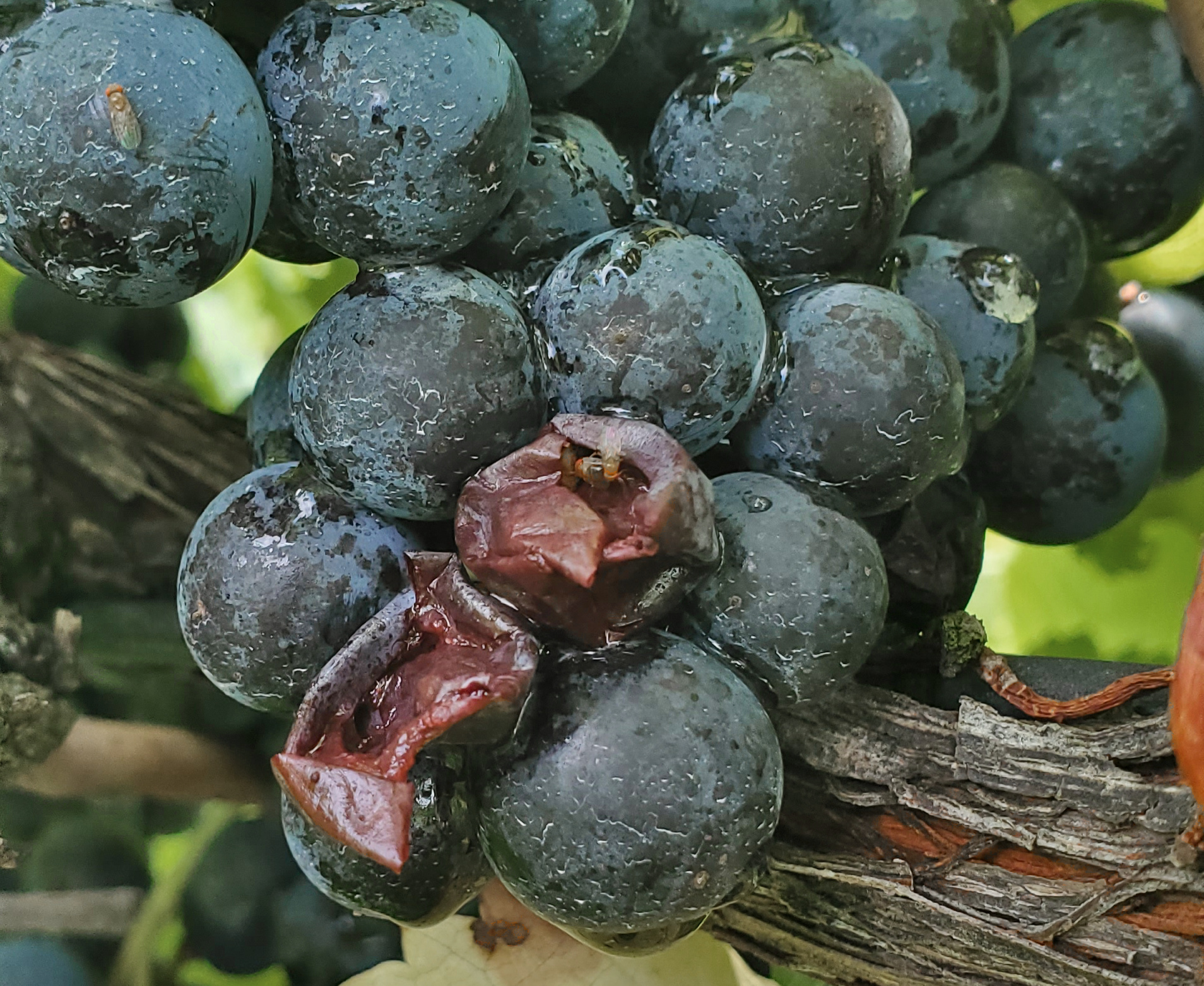Michigan grape scouting report – Aug. 25, 2021
Grape harvest is beginning in southwest Michigan. Veraison is underway further north.

Weather
Last week started cool and dry with high temperatures around 80 degrees Fahrenheit. Temperatures and humidity climbed on Wednesday, reaching near 90 in southwest Michigan, mid-80s in the rest of the state. The heat and humidity continued through the weekend, but no rain was recorded for the week.
The heat and humidity will continue in the southwest growing region with high temperatures near 90 for the next week. Southeastern areas will see mid-80s. Northwest growers will see highs around 80. Scattered chances of rain are expected all week throughout the state.
Last week we picked up a slightly above average number of growing degree days (GDD),140-170 GDD base 50. The southwest region is 495 GDD base 50 ahead of the northwest region. Statewide, we are a couple days ahead of the five-year average.
|
Northwest Michigan GDD summary from March 1 – Aug. 23, 2021 | |
|---|---|
|
Northwest stations |
GDD 50 F |
|
Petoskey (Petoskey) |
1738 |
|
Traverse City (NWMHRC) |
1888 |
|
Old Mission (Old Mission) |
1830 |
|
Average for northwest region |
1794 |
|
Average last week |
1653 |
|
Southern stations |
|
|
Benton Harbor (SWMREC) |
2341 |
|
Lawton (Lawton) |
2312 |
|
Fennville (TNRC) |
2107 |
|
Average for southwest region |
2288 |
|
Average last week |
2117 |
|
Romeo (Romeo) |
2213 |
|
Average for southeast region |
2241 |
|
Average last week |
2074 |
Vine growth
In southwest Michigan, most varieties are in the middle of or have completed veraison. Harvest is beginning this week on early wine grape varieties being picked for sparkling wine.
Veraison has begun in northern vineyards, and most grape varieties are softening and their acid levels are dropping.

|
Variety |
Northwest region (Brix) |
Southwest region (Brix) |
|---|---|---|
|
Riesling |
8.4 |
13.0 |
|
Chardonnay |
12.3 |
-- |
|
Pinot noir |
11 |
-- |
|
Pinot Blanc |
11.4 |
14.0 |
|
Zweigelt |
13.8 |
-- |
|
Pinot Gris |
12.6 |
14.0 |
|
Cabernet Sauvignon |
-- |
15.6 |
|
Merlot |
-- |
15.3 |
|
Sauvignon Blanc |
-- |
16.2 |
|
Seyval Blanc |
-- |
17.1 |
|
Valvin Muscat |
-- |
13.5 |
|
Concord |
-- |
11.0 |
|
Niagara |
-- |
10.9 |
Horticulture
At this time of the season, clusters greatly benefit from consistent sun exposure to reach the target fruit maturity. Together with leaf removal in the cluster zone, it is also important to apply crop control at the pre-veraison stage. This can be done using the green drop technique. Green drop is a grape-growing technique used to ensure the harvest of only the highest quality grapes. Grape clusters that are unlikely to ripen need to be removed. Near the end of veraison “green” fruit that are lagging behind the veraison stage are removed. This reduces the variability in the ripening of the fruit to be harvested.
During fruit maturation, bird damage can be a challenge in vineyards. Crop losses can reach up to 95% and 60% in red and white varieties, respectively. Several methods of protection can be implemented including the use of bird nets, streamers, scare-eye balloons, electronic bird distress calls and propane-fired bird-scaring cannons. For more information on these methods, see “Bird damage reduction strategies in viticultural practices.”
Weeds
Weed control is important at this time of the year to reduce weed interference in machine or manual harvest and to reduce the soil weed seed bank for the following season.
The application timing for most of the herbicides before harvest is mainly based on the pre-harvest interval (PHI). Aim (three-day PHI), Rely (14-day PHI) and Gramoxone (Restricted Use Pesticide) provide quick burn-down of weeds. Rely and Gramoxone control both broadleaves and grasses, but Aim is only effective for broadleaves. Venue (zero-day PHI) can be added to improve burn-down and broaden the weed control spectrum. Some herbicides will damage grape green bark, new shoots, leaves or vines, so minimize contact with vines during application.
Glyphosate also has a short 14-day PHI, but it is not advisable to apply it after bloom. Significant injury may occur during the current season or the following year if glyphosate comes in contact with leaves, green shoots or is absorbed by bark.
Detailed information related to the herbicide rates and efficacy on weeds can be obtained in the Herbicide section of E154 Michigan Fruit Management Guide, that contains lists of all currently labeled herbicides along with specific remarks for their use in vineyards.
Diseases
At this time of year, the main diseases to focus on are downy mildew and powdery mildew. These diseases are causing particular trouble for growers this year. The recent waves of rain and high humidity have created good conditions for repeated infection events. If they are permitted, fungicides that are broad-spectrum/contact like captan are effective products for resistance management. Viticultural practices that reduce canopy wetness such as good irrigation timing, leaf removal and good weed management can reduce these diseases in a vineyard.
The main concern with downy mildew at this time is late season defoliation. So far this season we have observed downy mildew more frequently than normal due to the high relative humidity and longer dew periods. Defoliation will impact winter hardiness and survival, as well as health of the vine next year. Effective fungicides for downy mildew include products in FRAC codes 4, 11, 21, 40 and 45 as well as phosphorus acid salts, captan and some biologically-based products.
Since many parts of the state are past veraison, this is also an important time to consider botrytis management. Botrytis has already been spotted in many early ripening varieties like Marquette or Aurore. Several strategies contribute to good botrytis bunch rot management including opening up the canopy, properly applying fungicides, and using resistant cultivars when possible. Good botrytis control depends on getting good coverage. Just before bunch closure is the last chance to apply a fungicide to the inner part of the developing cluster. The most effective products for botrytis are site specific and prone to resistance development. A Michigan Grape Fact Sheet is now available for managing botrytis bunch rot.

We have also been seeing sour rot in some vineyards in southwest Michigan. Sour rot is caused by a variety of microorganisms (e.g., yeasts and bacteria) and is often used as a catch-all for a variety of cluster problems. It is usually characterized by clusters that smell like vinegar, juice that drips over the fruit surfaces, a melting-type decay with skin slippage, and vinegar flies and fly larvae typically present. Recent research has shown a significant correlation between insect activity and sour rot movement. These insects have been primarily vinegar flies, but at MSU we have observed yellow jackets, honey bees, and bald-faced hornets on sour rot clusters.
Unfortunately, since sour rot is a disease complex involving many different yeasts and bacteria, we are still working to identify fungicides that are effective against sour rot. Recent research into a well-timed insecticide at 14 Brix along with a sterilant (e.g., Fracture or Oxidate) prior to sour rot symptoms is an effective method of control.

Remember as you choose a fungicide, check the guide for potential phytotoxicity of certain sprays on Concord grapes especially (this has been particularly noted for fungicides like Revus Top). Phytotoxicity risk is higher with high temperatures and quickly growing vines. Also, there is a significant phytotoxicity risk with specific contact products such as copper and sulfur for Labrusca type grapes (Concord and Niagara).
It is important to remember to manage fungicide resistance and avoid applying similar products back-to-back. This is particularly important with site-specific systemic fungicides. To reduce the development of resistance with systemic fungicides:
- Do not make more than two applications per season of the same FRAC code.
- Do not make two consecutive applications of the same FRAC code.
- Rotate with unrelated fungicides in a different FRAC code that have efficacy on the target pathogen.
- Include a contact multisite fungicide into a program (e.g., sulfur, captan, oils or biological fungicides).
Insects
The beginning of egglaying from the third generation of grape berry moth was predicted to begin the first week of August in southern Michigan. Management of this generation through August is important because this generation has the potential to reduce harvest.
So far this season, the levels of berry moth infestation have been much lower than usual across southwest Michigan. This is good news and we hope it stays that way. But with the timing of this third generation, we expect some of the larvae developing in August to continue through to adult stage for a fourth generation. This is just an early warning to keep an eye on this as we approach September and to continue scouting your own vineyards, especially if you have had historically high populations of grape berry moth. We will have more information on this in later reports.
Wasps and bees are starting to show up on ripening fruit. They are attracted to the accumulating sugars in the berries. Yellowjackets can be very damaging to the berries directly, causing wounds that can lead to cluster rots and reducing harvestable crop. They can also be frustrating to sprayers and harvest crews, trying to avoid being stung while working with the ripening grapes.
Vinegar flies are a fact of life in grape production, but with the presence of the invasive spotted wing Drosophila in Michigan it is more important to keep a regular check on clusters for development of vinegar flies in berries. The presence of vinegar flies in berries can be determined by putting fruit into a gallon bag with half a pint of strong salt solution for an hour, then looking in the solution to determine whether there are larvae present.
If treatment is needed, there are several short PHI insecticides available. Be aware, resistance has been documented for pyrethroids in vinegar flies in other states and is being evaluated in Michigan.

Upcoming events
Michigan Grape Society will be sponsoring one last evening Grower’s Social event before harvest begins. This event will be hosted by Michigan State University Extension at the Southwest Michigan Research and Extension Center on Thursday, Aug. 26, 2021. The event will begin at 6 p.m. with a discussion about season extension and winter protection through the use of high tunnels in grape production. Food and drink will follow. There will be limited attendance. Pre-registration is highly recommended.
Related articles
- Southwest Michigan fruit update – Aug. 24, 2021
- A Mobile Guide for Grape IPM Scouting in North Central and Eastern U.S.
- Mid-season management of grape berry moth
- Michigan grape scouting report – Aug. 11, 2021
- Pest management approaches in a winter or freeze damaged grape vineyard
- Bird damage reduction strategies in viticultural practices
- What can be done for late season downy mildew in grapes?



 Print
Print Email
Email




